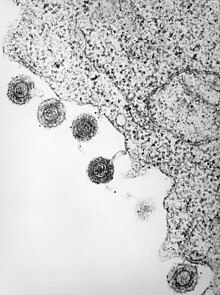
Back فيروس هربسي بشري 6 Arabic Humanes Herpesvirus 6 German Human herpesvirus 6 Spanish Herpèsvirus humain type 6 French ह्यूमेन हर्पसवाइरस ६ Hindi Herpesvirus umano 6 Italian ヒトヘルペスウイルス6 Japanese Herpesvírus humano 6 Portuguese Вирусы герпеса человека 6 типа Russian Humant herpesvirus 6 Swedish
| Human herpesvirus 6 | |
|---|---|

| |
| Electron micrograph of one of the HHV6 species | |

| |
| HHV-6 released from a lymphocyte which has been infected | |
| Scientific classification | |
| (unranked): | Virus |
| Realm: | Duplodnaviria |
| Kingdom: | Heunggongvirae |
| Phylum: | Peploviricota |
| Class: | Herviviricetes |
| Order: | Herpesvirales |
| Family: | Orthoherpesviridae |
| Subfamily: | Betaherpesvirinae |
| Genus: | Roseolovirus |
| Groups included | |
| Cladistically included but traditionally excluded taxa | |
|
All other Roseolovirus spp.: | |
Human herpesvirus 6 (HHV-6) is the common collective name for human betaherpesvirus 6A (HHV-6A) and human betaherpesvirus 6B (HHV-6B). These closely related viruses are two of the nine known herpesviruses that have humans as their primary host.[1]
HHV-6A and HHV-6B are double-stranded DNA viruses within the Betaherpesvirinae subfamily and of the genus Roseolovirus. HHV-6A and HHV-6B infect almost all of the human populations that have been tested.[2]
HHV-6A has been described as more neurovirulent,[3] and as such is more frequently found in patients with neuroinflammatory diseases such as multiple sclerosis.[4] HHV-6 (and HHV-7) levels in the brain are also elevated in people with Alzheimer's disease.[5]
HHV-6B primary infection is the cause of the common childhood illness exanthema subitum (also known as roseola infantum or sixth disease). It is passed on from child to child. It is uncommon for adults to contract this disease as most people have had it by kindergarten, and once contracted, immunity arises and prevents future reinfection. Additionally, HHV-6B reactivation is common in transplant recipients, which can cause several clinical manifestations such as encephalitis, bone marrow suppression, and pneumonitis.[6]
A variety of tests are used in the detection of HHV-6, some of which do not differentiate the two species.[7]
Both viruses can cause transplacental infection and be passed on to a newborn.[8]
- ^ Adams, M. J.; Carstens, E. B. (2012). "Ratification vote on taxonomic proposals to the International Committee on Taxonomy of Viruses (2012)". Archives of Virology. 157 (7): 1411–1422. doi:10.1007/s00705-012-1299-6. PMC 7086667. PMID 22481600.
- ^ Jaworska, J.; Gravel, A.; Flamand, L. (2010). "Divergent susceptibilities of human herpesvirus 6 variants to type I interferons". Proceedings of the National Academy of Sciences. 107 (18): 8369–74. Bibcode:2010PNAS..107.8369J. doi:10.1073/pnas.0909951107. PMC 2889514. PMID 20404187.
- ^ De Bolle, L.; Van Loon, J.; De Clercq, E.; Naesens, L. (2005). "Quantitative analysis of human herpesvirus 6 cell tropism". Journal of Medical Virology. 75 (1): 76–85. doi:10.1002/jmv.20240. PMID 15543581. S2CID 31720143.
- ^ Álvarez-Lafuente, Roberto; García-Montojo, Marta; De Las Heras, Virginia; Bartolomé, Manuel; Arroyo, Rafael (2006). "Clinical parameters and HHV-6 active replication in relapsing—remitting multiple sclerosis patients". Journal of Clinical Virology. 37: S24–6. doi:10.1016/S1386-6532(06)70007-5. PMID 17276363.
- ^ Readhead, Ben; Haure-Mirande, Jean-Vianney; Funk, Cory C.; Richards, Matthew A.; Shannon, Paul; Haroutunian, Vahram; Sano, Mary; Liang, Winnie S.; Beckmann, Noam D.; Price, Nathan D.; Reiman, Eric M.; Schadt, Eric E.; Ehrlich, Michelle E.; Gandy, Sam; Dudley, Joel T. (June 2018). "Multiscale Analysis of Independent Alzheimer's Cohorts Finds Disruption of Molecular, Genetic, and Clinical Networks by Human Herpesvirus". Neuron. 99 (1): 64–82.e7. doi:10.1016/j.neuron.2018.05.023. PMC 6551233. PMID 29937276.
- ^ Yoshikawa, Tetsushi (2004). "Human herpesvirus 6 infection in hematopoietic stem cell transplant patients". British Journal of Haematology. 124 (4): 421–32. doi:10.1046/j.1365-2141.2003.04788.x. PMID 14984492.
- ^ Flamand, Louis; Komaroff, Anthony L.; Arbuckle, Jesse H.; Medveczky, Peter G.; Ablashi, Dharam V. (2010). "Review, part 1: Human herpesvirus-6-basic biology, diagnostic testing, and antiviral efficacy". Journal of Medical Virology. 82 (9): 1560–8. doi:10.1002/jmv.21839. PMID 20648610. S2CID 33298246.
- ^ Komaroff, Anthony L.; Rizzo, Roberta; Ecker, Jeffrey L. (2021). "Human Herpesviruses 6A and 6B in Reproductive Diseases". Frontiers in Immunology. 12. doi:10.3389/fimmu.2021.648945. hdl:11392/2475148. ISSN 1664-3224. PMC 8027340. PMID 33841432.